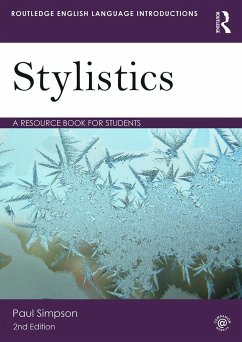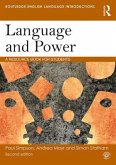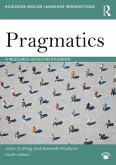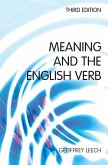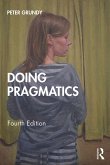- Broschiertes Buch
- Merkliste
- Auf die Merkliste
- Bewerten Bewerten
- Teilen
- Produkt teilen
- Produkterinnerung
- Produkterinnerung
Stylistics, Second Edition is an accessible and comprehensive introduction to literary stylistics.
Andere Kunden interessierten sich auch für
![Language and Power Language and Power]() Paul Simpson (UK Queen's University Belfast)Language and Power55,99 €
Paul Simpson (UK Queen's University Belfast)Language and Power55,99 €![Introducing English Language Introducing English Language]() Louise Mullany (UK University of Nottingham)Introducing English Language39,99 €
Louise Mullany (UK University of Nottingham)Introducing English Language39,99 €![Pragmatics Pragmatics]() Joan Cutting (UK University of Edinburgh)Pragmatics53,99 €
Joan Cutting (UK University of Edinburgh)Pragmatics53,99 €![Meaning and the English Verb Meaning and the English Verb]() Geoffrey N. LeechMeaning and the English Verb52,99 €
Geoffrey N. LeechMeaning and the English Verb52,99 €![Doing Pragmatics Doing Pragmatics]() Peter GrundyDoing Pragmatics41,99 €
Peter GrundyDoing Pragmatics41,99 €![Global Englishes Global Englishes]() Jennifer JenkinsGlobal Englishes152,99 €
Jennifer JenkinsGlobal Englishes152,99 €![Global Englishes Global Englishes]() Jennifer JenkinsGlobal Englishes33,99 €
Jennifer JenkinsGlobal Englishes33,99 €-
-
-
Stylistics, Second Edition is an accessible and comprehensive introduction to literary stylistics.
Hinweis: Dieser Artikel kann nur an eine deutsche Lieferadresse ausgeliefert werden.
Hinweis: Dieser Artikel kann nur an eine deutsche Lieferadresse ausgeliefert werden.
Produktdetails
- Produktdetails
- Routledge English Language Introductions
- Verlag: Taylor & Francis Ltd
- 2 ed
- Seitenzahl: 334
- Erscheinungstermin: 30. Januar 2014
- Englisch
- Abmessung: 246mm x 174mm x 18mm
- Gewicht: 574g
- ISBN-13: 9780415644976
- ISBN-10: 0415644976
- Artikelnr.: 39447818
- Herstellerkennzeichnung
- Libri GmbH
- Europaallee 1
- 36244 Bad Hersfeld
- gpsr@libri.de
- Routledge English Language Introductions
- Verlag: Taylor & Francis Ltd
- 2 ed
- Seitenzahl: 334
- Erscheinungstermin: 30. Januar 2014
- Englisch
- Abmessung: 246mm x 174mm x 18mm
- Gewicht: 574g
- ISBN-13: 9780415644976
- ISBN-10: 0415644976
- Artikelnr.: 39447818
- Herstellerkennzeichnung
- Libri GmbH
- Europaallee 1
- 36244 Bad Hersfeld
- gpsr@libri.de
Paul Simpson is a Professor of English Language in the School of English at Queen's University Belfast. He is best known for his books and articles in stylistics and critical linguistics and his publications in this area include Language, Ideology and Point of View, Language through Literature and the co-authored textbook Language and Power, all published by Routledge. He is the author of the monograph On the Discourse of Satire and from 2003 to 2009 was editor of Language and Literature, the journal of the International Poetics and Linguistics Association. He is currently writing a monograph on the linguistic pragmatics of irony.
A - Introduction: key concepts in stylistics
1 What is stylistics?
2 Stylistics and levels of language
3 Grammar and style
4 Rhythm and metre
5 Narrative stylistics
6 Style as choice
7 Style and point of view
8 Representing speech and thought
9 Dialogue and discourse
10 Cognitive stylistics
11 Metaphor and metonymy
12 New directions in stylistics: corpus approaches
B - Development: doing stylistics
1 Developments in stylistics.
2 Levels of language at work: an example from poetry
3 Sentence styles: development and illustration
4 Interpreting patterns of sound
5 Developments in structural narratology
6 Style and transitivity
7 Approaches to point of view
8 Techniques of speech and thought presentation
9 Dialogue in drama
10 Developments in cognitive stylistics
11 Styles of metaphor
12 Developments in corpus stylistics
C - Exploration: investigating style
1 Is there a "literary language"?
2 Style, register and dialect
3 Grammar and genre: a short study in Imagism
4 Styles in a single poem: an exploration
5 A sociolinguistic model of narrative
6 Transitivity, characterisation and literary genre
7 Exploring point of view in narrative fiction
8 A workshop on speech and thought presentation
9 Exploring dialogue
10 Cognitive stylistics at work
11 Exploring metaphors in different kinds of texts
12 Using corpora in stylistic analysis
D- Extension: readings in stylistics.
1 Stylistics and the teaching of literature (Henry Widdowson)
2 Style and verbal play (Katie Wales)
3 Teaching grammar and style (Ronald Carter)
4 Sound, style and onomatopoeia (Derek Attridge)
5 A typology of narrative gaps (Donald Hardy)
6 Transitivity at work (Deirdre Burton)
7 Style variation and point of view (Mick Short)
8 The effects of free indirect discourse (Joe Bray)
9 Multi-modal analysis and the stylistics of drama (Dan McIntyre)
10 Conceptual blending and stylistic analysis (Barbara Dancygier)
11 Cognitive stylistics and the theory of metaphor (Peter Stockwell)
12 Corpus stylistics (Michaela Mahlberg and Catherine Smith)
1 What is stylistics?
2 Stylistics and levels of language
3 Grammar and style
4 Rhythm and metre
5 Narrative stylistics
6 Style as choice
7 Style and point of view
8 Representing speech and thought
9 Dialogue and discourse
10 Cognitive stylistics
11 Metaphor and metonymy
12 New directions in stylistics: corpus approaches
B - Development: doing stylistics
1 Developments in stylistics.
2 Levels of language at work: an example from poetry
3 Sentence styles: development and illustration
4 Interpreting patterns of sound
5 Developments in structural narratology
6 Style and transitivity
7 Approaches to point of view
8 Techniques of speech and thought presentation
9 Dialogue in drama
10 Developments in cognitive stylistics
11 Styles of metaphor
12 Developments in corpus stylistics
C - Exploration: investigating style
1 Is there a "literary language"?
2 Style, register and dialect
3 Grammar and genre: a short study in Imagism
4 Styles in a single poem: an exploration
5 A sociolinguistic model of narrative
6 Transitivity, characterisation and literary genre
7 Exploring point of view in narrative fiction
8 A workshop on speech and thought presentation
9 Exploring dialogue
10 Cognitive stylistics at work
11 Exploring metaphors in different kinds of texts
12 Using corpora in stylistic analysis
D- Extension: readings in stylistics.
1 Stylistics and the teaching of literature (Henry Widdowson)
2 Style and verbal play (Katie Wales)
3 Teaching grammar and style (Ronald Carter)
4 Sound, style and onomatopoeia (Derek Attridge)
5 A typology of narrative gaps (Donald Hardy)
6 Transitivity at work (Deirdre Burton)
7 Style variation and point of view (Mick Short)
8 The effects of free indirect discourse (Joe Bray)
9 Multi-modal analysis and the stylistics of drama (Dan McIntyre)
10 Conceptual blending and stylistic analysis (Barbara Dancygier)
11 Cognitive stylistics and the theory of metaphor (Peter Stockwell)
12 Corpus stylistics (Michaela Mahlberg and Catherine Smith)
A - Introduction: key concepts in stylistics
1 What is stylistics?
2 Stylistics and levels of language
3 Grammar and style
4 Rhythm and metre
5 Narrative stylistics
6 Style as choice
7 Style and point of view
8 Representing speech and thought
9 Dialogue and discourse
10 Cognitive stylistics
11 Metaphor and metonymy
12 New directions in stylistics: corpus approaches
B - Development: doing stylistics
1 Developments in stylistics.
2 Levels of language at work: an example from poetry
3 Sentence styles: development and illustration
4 Interpreting patterns of sound
5 Developments in structural narratology
6 Style and transitivity
7 Approaches to point of view
8 Techniques of speech and thought presentation
9 Dialogue in drama
10 Developments in cognitive stylistics
11 Styles of metaphor
12 Developments in corpus stylistics
C - Exploration: investigating style
1 Is there a "literary language"?
2 Style, register and dialect
3 Grammar and genre: a short study in Imagism
4 Styles in a single poem: an exploration
5 A sociolinguistic model of narrative
6 Transitivity, characterisation and literary genre
7 Exploring point of view in narrative fiction
8 A workshop on speech and thought presentation
9 Exploring dialogue
10 Cognitive stylistics at work
11 Exploring metaphors in different kinds of texts
12 Using corpora in stylistic analysis
D- Extension: readings in stylistics.
1 Stylistics and the teaching of literature (Henry Widdowson)
2 Style and verbal play (Katie Wales)
3 Teaching grammar and style (Ronald Carter)
4 Sound, style and onomatopoeia (Derek Attridge)
5 A typology of narrative gaps (Donald Hardy)
6 Transitivity at work (Deirdre Burton)
7 Style variation and point of view (Mick Short)
8 The effects of free indirect discourse (Joe Bray)
9 Multi-modal analysis and the stylistics of drama (Dan McIntyre)
10 Conceptual blending and stylistic analysis (Barbara Dancygier)
11 Cognitive stylistics and the theory of metaphor (Peter Stockwell)
12 Corpus stylistics (Michaela Mahlberg and Catherine Smith)
1 What is stylistics?
2 Stylistics and levels of language
3 Grammar and style
4 Rhythm and metre
5 Narrative stylistics
6 Style as choice
7 Style and point of view
8 Representing speech and thought
9 Dialogue and discourse
10 Cognitive stylistics
11 Metaphor and metonymy
12 New directions in stylistics: corpus approaches
B - Development: doing stylistics
1 Developments in stylistics.
2 Levels of language at work: an example from poetry
3 Sentence styles: development and illustration
4 Interpreting patterns of sound
5 Developments in structural narratology
6 Style and transitivity
7 Approaches to point of view
8 Techniques of speech and thought presentation
9 Dialogue in drama
10 Developments in cognitive stylistics
11 Styles of metaphor
12 Developments in corpus stylistics
C - Exploration: investigating style
1 Is there a "literary language"?
2 Style, register and dialect
3 Grammar and genre: a short study in Imagism
4 Styles in a single poem: an exploration
5 A sociolinguistic model of narrative
6 Transitivity, characterisation and literary genre
7 Exploring point of view in narrative fiction
8 A workshop on speech and thought presentation
9 Exploring dialogue
10 Cognitive stylistics at work
11 Exploring metaphors in different kinds of texts
12 Using corpora in stylistic analysis
D- Extension: readings in stylistics.
1 Stylistics and the teaching of literature (Henry Widdowson)
2 Style and verbal play (Katie Wales)
3 Teaching grammar and style (Ronald Carter)
4 Sound, style and onomatopoeia (Derek Attridge)
5 A typology of narrative gaps (Donald Hardy)
6 Transitivity at work (Deirdre Burton)
7 Style variation and point of view (Mick Short)
8 The effects of free indirect discourse (Joe Bray)
9 Multi-modal analysis and the stylistics of drama (Dan McIntyre)
10 Conceptual blending and stylistic analysis (Barbara Dancygier)
11 Cognitive stylistics and the theory of metaphor (Peter Stockwell)
12 Corpus stylistics (Michaela Mahlberg and Catherine Smith)

